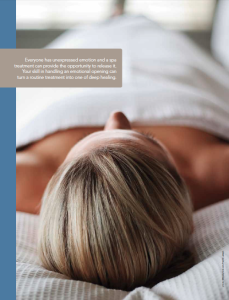
Tears on the Table – When Your Client Needs to Cry
What do you do when your client or patient bursts into tears? At first, you wonder if you did something to set the person off. However, after seeing this time and time again, you learn not to take it personally and to hold space for the tears to flow.
Everyone has unexpressed emotion and a spa treatment can provide the opportunity to release it. Your skill in handling an emotional opening can turn a routine treatment into one of deep healing. Whether you want to expand your ability to facilitate emotional release or simply want to understand more fully what is going on, there are some things to consider when the tears start to flow.
Understanding your client
Every client who comes to you is a complex and fascinating composite of physical, mental, emotional and spiritual energy, all blended to form a whole. You can’t pinpoint where the emotional becomes physical or where the mental turns into the spiritual – and you do not need to. We all have emotional energy trapped in our bodies. It’s an important starting point to recognizing that releasing that energy is normal, natural and healthy. In additional to the stresses of daily life, a client could be in a relationship crisis; grieving the death of a loved one; worried about a sick child or addicted teenager; or juggling financial worries. It’s so common for so many to run from one demand to another without taking adequate time to rest and process emotion, which makes the energy and stress accumulate.
Underlying day-to-day stress is the emotion that we stifled growing up. Learning not to express what we are feeling—not to hit when angry, or shriek in excitement—is part of socialization. Girls are typically discouraged from expressing angry or powerful emotions. Boys are often ridiculed if they cry or show emotion that appears “weak.” We quickly learn to suppress emotions that are not socially acceptable. Then there is all that stuffed-down pain from being unseen or badly treated. Our mothers tell us—in subtle and not-so-subtle ways— that we are not beautiful or our fathers say we are not good enough. Many of us have been emotionally abused without putting that label on it.
We accumulate layer after layer of sadness, fear, anger— even joy that could not be expressed—by stuffing down the energy with held or limited breath. We naturally and unconsciously hold our breath when we are scared or do not want to feel something. Then early on, we learn to suck in our stomach in order not to look “fat.”
Those two patterns compound to create a habit of holding in our stomach, breathing minimally and not feeling much. This also cuts off our access to our intuitive wisdom as the rational mind takes over and we live in our heads.
Reprogram the clutch
Fortunately we can interrupt this loop by allowing the belly to expand, opening the breathing and allowing emotional energy to flow on through. It is a huge relief when long-held emotions finally get to move on through and out.
Breathing is the key. It serves as the transport vehicle out of the head and into the body, where the emotional energy is stored, waiting for release. Breathing is also the access point for the intuitive wisdom we all have.
Both you and your client have to be willing to breathe fully, i.e., puff out your stomach with the inhale, and hold it empty after the exhale. You can inhale and exhale simultaneously with the client to connect with them. This is how you regain access to the intuitive strength in your body – which is where the unwanted emotions are held, having been stuffed down for processing “later.” When emotions overflow in a treatment, that “later” has become “now.”
Give the gift of your attention
You can give your clients an amazing gift simply by understanding this and surrendering to what is happening in the moment. You do not need a degree in psychology or be a high-level intuitive to facilitate healing. It only takes willingness to breathe deeply and go within and hold a space for potentially uncomfortable emotions. The more you practice this, the more you will gain confidence in your intuitive ability.
You can tell you are in that open, intuitive space if you feel loving, warm and clear. Thoughts and impulses seem to come from somewhere other than your mind. Time stops and you feel connected up and out of your own personality. When you have touched the right point, it can feel like plugging into an electrical current.
The idea is to bring a child-like wonder and curiosity to the moment you share with your client. Let go of any preconceived ideas, agenda, and judgment. Let the body lead the way. If you do not understand something you feel in a client’s body, ask it directly. It is amazing how willing most bodies are to “speak” when given a sincere and willing ear. You create the opening with an attitude of allowing far more than with any particular technique. Adding your breath and intuitive insight to the knowledge and experience you already have will expand the healing possibilities of your practice immensely.
Key points
To bring all this into a session, it will help to remember the following points.
- Remind your client to breathe when you see them hold their breath. They may be clenching their muscles and holding their breath to suppress scary or overwhelming emotion. Remember that it is just energy that is moving. Sometimes the expanded breathing allows held emotion move through without much drama. If the drama and energy increase, that is your cue to deepen both their breath and yours. Like a wave, the emotional energy will eventually run its course. Your acceptance and lack of fear will set the tone for them.
- Deepen your attitude of acceptance and allowing. This way you create a space for feelings and clients can let down their defenses.
- Suspend your judgment as much as you can and simply see them as a person, possibly in pain, and definitely in need of comfort. Whatever they are working through is their business. You do not have to have the answer for them or solve the problem—in fact it is better if you do not. Your biggest gift is to be a nonjudgmental witness.
- Safety – Clients may want to release the emotional burdens they carry, but not feel that it is safe or socially acceptable to go into anything deep. Your accepting attitude will allow them to meet the layers of emotions tangled within. They will find their own resolution if given the space to do so. If you feel soft and compassionate, they will sense it and relax.
- Make sure you are breathing fully. Take a deep breath yourself and relax. If you are worried about their emotions, they will be, too. As you breathe, you will relax and they will naturally begin to open their breathing to entrain with yours. As you slow down and connect within, so will your client. Have them deepen their breath. This will help release the stuck energy. All you have to do is hold the space, breathe and open yourself.
- Ask questions and encourage them. Ask gentle questions like, “what did you feel?” or “can you describe what just happened?” If you feel something—warmth, energy flow, see a color, etc.—ask your client if they had the same experience. Often you will have similar experiences, but your client may not have the vocabulary or confidence to speak first. If you describe what you notice, e.g., “I noticed your shoulder relax,” you give an opening for them to comment further. As you practice, you will gain confidence in your ability to intuit what is going on and respond appropriately.
- Do not be afraid to ask the body what it wants … silently or out loud. It is amazing how willing most bodies are to “speak” when given a sincere audience. You can say something like, “if your shoulder could speak, what would it say?” The opening comes more from an attitude of allowing than any given technique. If you understand that emotional energy is part of a person and that it simply needs a safe place to release, you will more easily get out of the way and facilitate the process.
Always go back to the breath
- Always go back to the breathing. Whatever your client is feeling, it is simply energy, even if it is intense, and breathing is the vehicle for it to move and release. You can easily see and feel when they are holding their breath or breathing shallowly. If you see your client is breathing shallowly or holding the breath, that is a sign they are unconsciously working to hold down emotional energy that is trying to surface. Encourage them to breathe.
- Trust that what is meant to happen, will. While everyone has emotional energy that might need to be released, not everyone is willing or ready.
And you may not be the right one to release it at that moment. Don’t push, but simply offer the opportunity and wait to see what happens.
I can’t tell you how many times I stayed present, followed my intuition and then thought nothing particular happened only to have my client say, “that was exactly what I needed.”
- Help your client come to closure well before the end of the session. As you are nearing the end of the treatment time, if your client still has strong emotions running, do not be afraid to explain the limits of your setting. If you can extend the time, offer that possibility. If not, ask, “what can we do to bring this to a safe and satisfying conclusion?” You don’t want to dredge up more than they can process in that situation. Often simply acknowledging that they are not finished and that you want to accommodate their process is healing. They might not know exactly what they need, but discussing it is better than ignoring it or abruptly cutting them off.


